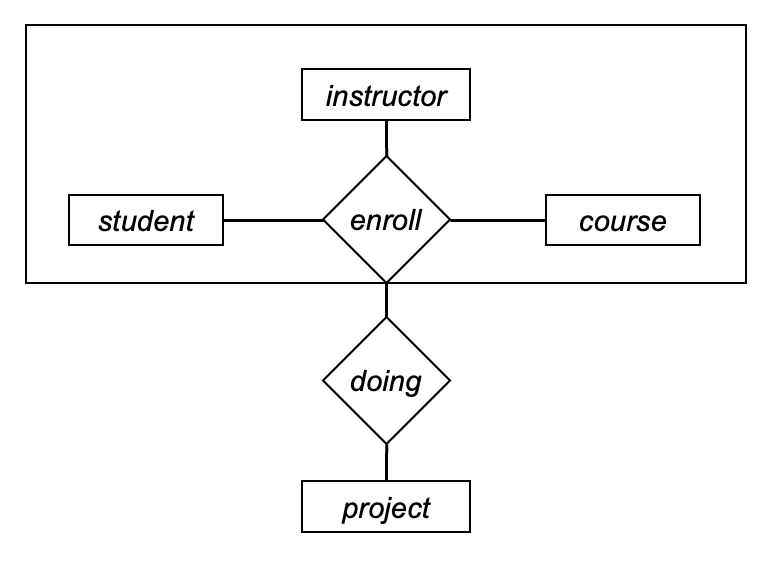Title: "[[Entity-Relationship-Model-Extended-Features]]"
status: DONE
tags:
- DataBase
- NOTE
- Lec3
Author:
- AllenYGY
created: 2023-11-03T00:59
updated: 2024-03-21T21:36Entity-Relationship-Model-Extended-Features
- Aggregation 聚合
- Weak Entity Sets
- Generalization and Specialization
Aggregation
let “student”, “instructor”, “course”, and “enroll” form an abstract entity as an aggregation. Then “project” only need to associate with the courses which has a course project.

Weak Entity Sets
A weak entity is an entity cannot exist alone. The existence depends on another entity of a different type.
弱实体不单独存在,必须依附于实体
A set of weak entities is a weak entity set. Since a weak entity cannot exist alone, it does not have a key.
The existence of a weak entity set depends on the existence of an identifying entity set.
-
A weak must relate to the identifying entity set via a total, one-to-many relationship set from the identifying to the weak entity set.
-
An identifying relationship depicted using a double diamond. 用双线菱形表示identifying relationship
-
The discriminator(鉴别器) (or partial key) of a weak entity set is the set of attributes that distinguishes among all the entities of a weak entity set.
To distinguish weak entities, one must combine the key of the identifying entity set and the discriminator -
Example
Our original modeling for courses was not accurate.
Instead of saying “a student is enrolled to a course”, it’s better to say, “a student is enrolled to a section of a course”.
Same for instructors, one instructor may teach multiple sections of one course.
An entity set “section” is needed.
But a section needs to be with a course.
Thus, “section” is a weak entity set which depends on “course”.

Double rectangles denote weak entity sets. 双矩形边框 表示weak entity
Dashed underlines denote discriminators of weak entity sets. 虚线下划线 表示 weak entity的键
Double diamonds denote identifying relationship sets.
Assume we model the original “enroll” relationship set without constraints. [1]
Generalization & Specialization
-
Generalization (泛化) is the process of extracting common properties from a set of entities and create a generalized entity from it. It is a bottom-up approach in which two or more entities can be generalized to a higher level entity if they have some attributes in common.
-
specialization (具象化), an entity is divided into sub-entities based on their characteristics. It is a top-down approach where higher level entity is specialized into two or more lower level entities.
-
泛化 抽象实体集的共同特征 bottom-up
-
具象化 Top-down
-
Does one higher-level entity belong to at least one lower-level entity set?
If yes, this ISA is a total generalization.
If no, this ISA is a partial generalization -
Does one higher-level entity belong to multiple lower-level entity set?
If No, it is a disjoint generalization.
If no, it’s a overlapping generalization -
Similar to the Inheritance

Cardinality constraints and participation constraints can be applied on ISA relationship sets.
But some constraints are omitted because
each entity on the lower-level is one entity on the higher-level (the entity sets on the lower-level always fully participate ISA);
one entity cannot be associated with multiple entities in the same entity set on the lower-level.
Thus, the constraints on ISA only discuss
Does one higher-level entity belong to at least one lower-level entity set?
If yes, this ISA is a total generalization.
Does one higher-level entity belong to multiple lower-level entity set?
If No, it is a disjoint generalization.
The above design process is bottom-up, combining several entity sets with same attributes into higher-level entity set.
But sometimes the process is reversed.
Some entity sets can be split into some lower-level entity sets with specific attributes.
This top-down process is called specialization.
Consider the “student” and “instructor” example.
If we want to express every person is either a student or an instructor, then this is a total generalization.
And if we assume nobody can be a student and an instructor at the same time, this is a disjoint generalization.

- 我的评价是真sharuan↩︎